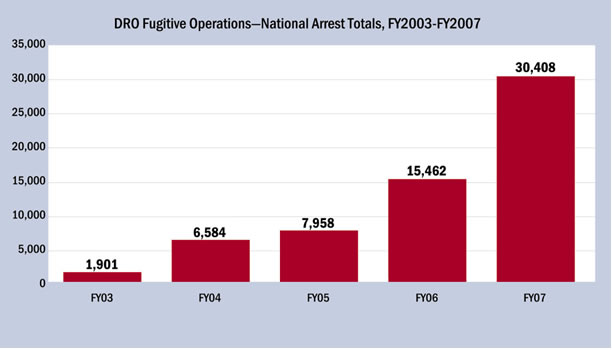
Search
Info Updates
National Threat Advisory
Elevated
![]()
Significant Risk of Terrorist Attacks
Report Suspicious Activity:
1-866-DHS-2-ICE1-866-347-2423
Information for families of ICE detainees:
Contact InformationNews Releases
December 20, 2007
ICE Fugitive Operations Teams in Maryland arrest more than 924 fugitives and immigration status violators
Arrests nearly double locally and nationally compared to the previous fiscal year
BALTIMORE, MD - U.S. Immigration and Customs Enforcement (ICE) announced today that deportation officers assigned to the Baltimore Office made a record number of arrests in fiscal year 2007. The Baltimore Field Office area of responsibility covers all of Maryland. In the Baltimore Field Office, there were 924 arrests made in FY 2007 - an increase from the 592 arrests made in FY 2006.
ICE established its Fugitive Operations Program in 2003 to eliminate the nation's backlog of immigration fugitives and ensure that deportation orders handed down by immigration judges are enforced. The teams prioritize cases involving immigration violators who pose a threat to national security and community safety. These include child sexual exploiters, suspected gang members and those who have convictions for any violent crimes.
In the last fiscal year, which ended on Sept. 30, 2007, ICE Fugitive Operations Teams arrested 30,408 individuals nationwide - up from 15,462 arrests made in FY 2006. One of the reasons for the increase in arrests is the deployment of additional teams across the country. At the end of FY 2007, ICE had 75 active teams, up from 52 teams at the end of FY2006. Two of those teams are located within the Baltimore Field Office.
The Fugitive Operations Program's rapid growth has spurred its success. Increased information sharing with state and local law enforcement and more efficient data collection and dissemination has also contributed greatly. On December 6-7, 2007, the teams worked jointly with MD Division of Parole and Probation in Frederick County as part of "Operation Secure Streets." The two-day operation generated 17 arrests. Aliens arrested during the operation were from the countries of Mexico, Guatemala, Honduras, El Salvador, and Ghana.
ICE has also expanded partnerships with local law enforcement agencies across the country through the newly created Fugitive Operations Support Center (FOSC) in Vermont, which aids in gathering and analyzing information on fugitive cases across the country. This center was opened last year and has since disseminated more than 150,000 case leads to ICE agents.
As of October 1, 2007, ICE's fugitive case backlog consisted of less than 595,000 fugitive aliens. This total is approximately 38,000 fewer fugitives than the population recorded on October 1, 2006, and marks the first time that fugitive arrests have out paced the annual number of new absconders.
"These statistics clearly show our continued commitment to locate, arrest and remove individuals who violate our immigration laws," said Calvin McCormick, Baltimore Field Office Director for Detention and Removal. "We will continue to intensify efforts against those who blatantly violate our laws, as part of ongoing efforts to increase national security and protect our communities. The rule of law must be respected."
ICE's Fugitive Operations Program is an integral part of the comprehensive multi-year plan launched by the Department of Homeland Security to secure America's borders and reduce illegal migration. That strategy seeks to gain operational control of both the northern and southern borders, while re-engineering the alien detention and removal system to ensure that illegal aliens are removed from the country quickly and efficiently.

-- ICE --






